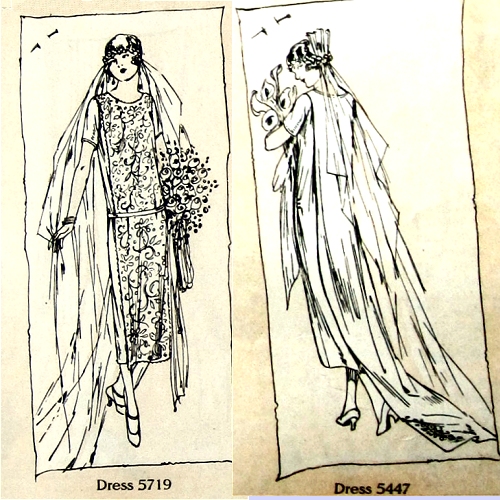The stylized roses of the 1920’s are lovely, and putting just one on a simple dress can really make it look authentic.

A wedding dress with a single, large beaded rose at the hip. Butterick 6224 from October 1925. Delineator. It would be equally attractive (and authentic) in black or gold beads on black satin, or white beads on pink, silver beads on pale blue, etc.

The Robe de Style from 1926 has two spiraling beaded flowers on the skirt, and a band of beading on the cape-like collar. Butterick embroidery transfer 10472, on dress pattern 7047.
I’m not suggesting that you make a dress like this one for your first beading project:

Butterick 6227, October 1925.
However, here is the beading pattern that was used. It appeared in Delineator in May of 1925. It is Butterick embroidery design 10340.

Butterick beading transfer 10340 offered the stylized rose in several variations — a single rose, a rose with tendrils, and the large repeating pattern used on wedding dress pattern No. 6227.

Butterick transfer 10340, May 1925. Work it in beads or in French knots.
You can actually count the beads. Putting a rose like the one in the center on the ends of a chiffon sash or the neckline of a dress would not really take very long. For that matter, you could do it in rhinestones on a T-shirt or in studs on the back of a leather jacket!

A photograph of one beaded rose. Delineator. A larger rose would take more beads or bigger beads.
In a smaller scale — or with bigger beads — this rose could also decorate the side of a cloche hat. You can play with designs, like this….

Top, the pattern turned sideways; bottom, used as a applique with two sets of tendrils.
… Moving or combining them, enlarging them as needed. Sometimes an applique was beaded.
Here is another Butterick rose beading pattern:

Embroidery transfer 10378, Delineator, October 1925.

Butterick embroidery transfer pattern 10378, October 1925. Delineator. “For dresses, blouses, scarfs, coats, etc.”
It’s easy to envision the large motif embroidered on a pillowcase with a scalloped edge, but it would also be perfect beaded on the hem of a 1920’s chiffon dress, or even on the front and back panels of a wedding gown:

Bridal dresses, April 1925. Butterick patterns 5719 and 5447.
You could work these embroidery patterns in beads or shiny silk embroidery floss on dresses, or in cotton on pillowcases, although French knots do make quite an impression on your cheek!

This late teens or early twenties blouse is trimmed with shiny silk floss embroidery, appliques of orange fabric, and beading plus embroidery on top of the appliques. Rows of French knots in apricot and ice blue silk look like beading, but they are not. They’re knots :).
I once beaded just the bust area on a 1950’s cocktail dress for a play — enhancing the existing champagne colored brocade with small pearls and gold sequins and beads. I was amazed by how much a few hours of beading while watching (OK, listening to) TV enhanced the actress’ figure. (A new mother, she was self-conscious about the size of her post-delivery hips. The beading helped to balance her hips by making the top part of the dress more interesting.)

The yoke and hip band on this vintage blouse were trimmed with pale, translucent beads for a subtle effect.
It’s is also possible to use lace trim and ornament it with just a few beads for sparkle. Look at the impact that made on this satin dress from earlier in the 20th century:

Lace was applied to the satin and enhanced with matching gold-bronze beads. Lots of impact, but very little hand beading.
I’m sure there are plenty of “how to apply beads” videos available. I’m no expert, but what I recommend is:
Use a beading needle. Attach each bead or group of 3 or 4 beads using a backstitch. (Backstitch through the beads.) Do not use a running stitch, or a pull on one bead will pucker your material. Knot off every two or three inches, so a single broken thread won’t dump all your beautiful beading onto the floor. (Don’t cut the thread, just continue after stitching in a knot.) A free-standing embroidery hoop is useful, so you can work with your more skillful hand underneath and your less skillful hand on top, where you can see what it’s doing. ( Q: “How do you get to Carnegie Hall?” A: ” Practice.”)

In spite of the blurred photo, you can appreciate the opaque white and pink beading on this peachy pink vintage dress. The pieces were probably professionally beaded before being assembled into a dress.
